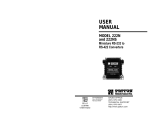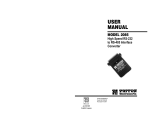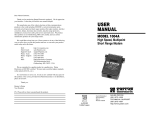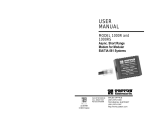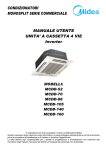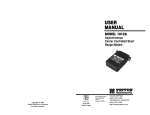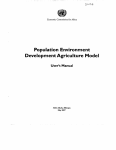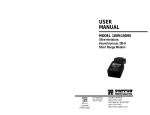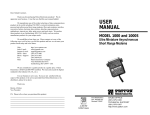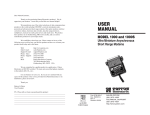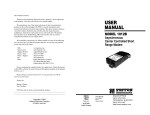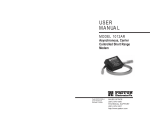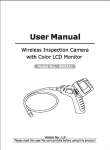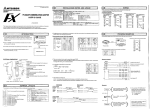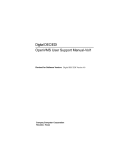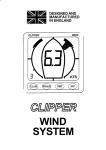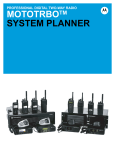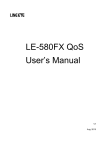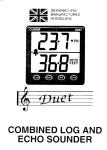Download model 222n
Transcript
USER MANUAL 2.1 FEATURES l l l MODEL 222N and 222NS Miniature RS-232 to RS-422 Converters l l l l Bi-directionally converts RS-232 signals to balanced RS-422 DCE/DTE switch selectable on RS-232 interface Supports transmit and receive data (X-ON/X-OFF flow control) Loops back all handshaking signals on the RS-232 interface Very thin case (.75") for closely spaced computer ports No AC power or batteries required-draws all necessary operating power from RS-232 interface Supports data rates to 19.200 bps 2.2 DESCRIPTION The Patton Model 222N interface converter allows computers, terminals and modems employing the RS-232E interface to communicate with devices using RS-422 balanced electrical signals. This unit derives the necessary power for operation from the data and control voltages on the RS-232 interface. The 222N features bi-directional data conversion at full or half duplex at distances up to 3.5 miles. An external DCE/DTE switch lets you connect to the serial port of either a computer/terminal (DTE) or a modem (DCE) without using a crossover cable. The Model 222N is available with several RS-422 interface options: DB-25 male or female (following the RS-530 standard), RJ-11, RJ-45, or terminal blocks with strain relief. The surge protected Model 222NS uses high speed avalanche diodes to intercept data line transient surges and shunt them safely to chassis ground. With surge handling capacity of 600W per wire at 1 mS, the 222NS can protect itself and connected equipment from nearby lightning strikes, and other surges of electromagnetic radiation. 3.0 CONFIGURATION 4.0 INSTALLATION The Model 222N is designed to be easy to use. There are no internal jumpers or DIP switches to set, so there is no need to open the case to configure the unit (you may need to open the case for wire connection-refer to section 4.0). The only configuration necessary for operation is proper setting of the external DTE/DCE switch. Once you have properly configured the DTE/DCE switch, you are ready to connect the Model 222N to your system. This section tells you how to properly connect the Model 222N to the RS-422 and RS-232 interfaces, and how to operate the Model 222N. The figure below shows the location of the DTE/DCE switch on the PC board, as well as the location of the terminal block and surge suppressors (“S” model only). 4.1 CONNECTION TO THE RS-422 DCE/DTE Switch L 1 . 1 Surge Suppressors (222NS only) lW/ Terminal INTERFACE The Model 222N supports data-only communication distances up to 4000 feet between itself and the RS-422 device. To function properly, the Model 222N must have two twisted pairs of metallic wire. These pairs must be dry, unconditioned metallic wire, between 19 and 26 AWG (the higher number gauges may limit distance somewhat). For your convenience, the Model 222N is available with several different physical interfaces on the RS-422 side: DB-25 (following the RS-530 standard), RJ-11 jack, RJ-45 jack, and terminal blocks with strain relief. 0 4.1.1 RS-422 CONNECTION USING THE DB-25 3.1 SETTING THE DTE/DCE SWITCH For your convenience, the Model 222N has an externally accessible DTE/DCE switch (see diagram below). If the device connected to the Model 222N is a modem or multiplexer (or is wired like one), set the switch to “DTE”. This setting causes the Model 222N to behave like Data Terminal Equipment and transmit data on pin 2. If the device connected to the Model 222N is a PC, terminal or host computer (or is wired like one), set the switch to “DCE”. This setting causes the Model 222N to behave like Data Communications _ Equipment and transmit data on pin 3. The DB-25 connector on the Model 222N’s RS-422 side conforms to the RS-530 interface standard. When connecting to an RS-422 device that also conforms to the RS-530 standard, your cable should be *crossed over’ in the manner shown below: MODEL 222N AS-422 (530) DEVICE SlGNAL DB-25 PIN SIGNAL DB-25 PIN XMT+ 2 ............................ 3 RCV+ XMT14 . . . . . . . . . . . . . . . . . . . . . . . . . . 16 RCVRCV+ RCV- 3 ............................ 2 16 . . . . . . . . . . . . . . . . . . . . . . . . . . 14 XMT+ XMT- ‘The DB-25 connector that is farthest from the DT E/DCE switch NOTE: It is not necessary that the RS-422 device adhere to the RS-530 standard. However, you must make sure that the signals. polarities. and pairing of your connection conform to the above diagram. 4.1.2 RS-422 CONNECTION USING RJ-11 OR RJ-45 4.1.3 RS-422 CONNECTION USING TERMINAL BLOCKS The RJ- 11 and RJ-45 connectors on the Model 222N’s RS-422 side are pre-wired for a standard ‘TELCO wiring environmenr. The signal/pin relationships are shown below: SIGNAL RJ-11 RJ-45 1 ................... GND’ 2 ................... RCV3.. ................. XMT+ 4.. ................. XMT5.. ................. RCV+ 6.. .................GND SlGNAL 1 ................. N/C 2 ................. GND’ 3 ................. RCV4 ................. XMT+ 5 ................. XMT6 ................. RCV+ 7 ................. GND 8 ................. N/C If your RS-422 application requires you to connect two pairs of bare wires to the Model 222N, you wilt need to open the case to access the terminal blocks. The following instructions will tell you how to open the case, connect the bare wires lo the terminal blocks, and fasten the strain relief collar in place so that the wires won't pull loose. 1. Open the unit by gently inserting a screwdriver between the DB-25 connector and the lip of the plastic case (see below). You don’t have to worry about breaking the plastic, but be careful not to bend the D-sub connector. In most modular RS-422 applications, it is necessary to use a "cross over” cable. The diagram below shows how a cross over cable should be constructed for an environment where both the Model 222N and the RS-422 device use a 6-wire RJ-11 connector. Similar logic should be followed when using RJ-45 connectors or a combination of the two. MODEL 222N SIGNAL PIN COLOR GND’ RCVXMT+ XMTRCV+ GND’ 1 2 3 4 5 6 RS-422 DEVICE COLOR PIN# 422 SlGNAL Blue’ . . . . . . . . . . . . . . . . N/C Yellow . . . . . . . . . . . . . . Red Green . . . . . . . . . . . . . . . Black Red . . . . . . . . . . . . . . . :..Yellow Black . . . . . . . . . . . . . . . . Green White . . . . . . . . . . . . . . . N/C ‘Connection to ground is optional 4 5 2 3 XMTRCV+ RCVXMT+ Once the unit has been opened, you will be able to see the terminal blocks located a! the rear of the PC board. 2. Strip the outer insulation from the twisted pairs about one inch from the end. ‘Standard AT& T color codes-yours may be different 4.3 OPERATING THE MODEL 222N 3. Strip back the insulation on each of the 2 twisted pair wires about .25”. Once the Model 222N is properly installed, it should operate transparently-as if it were a standard cable connection. Operating power is derived from the RS-232 data and control signals; there is no “ON/OFF” switch. All data signals from the RS-232 and RS-422 interfaces are passed straight through. All control signals from the RS232 interface are looped back. 4. Connect one pair of wires to XMT+ and XMT- (transmit positive and negative) on the terminal block, making careful note Of which color is positive, and which color is negative. (Note: If your system requires hardware flow control, you will need the Patton Model 265 RS-232 to RS-485 converter. Call Patton Customer Service at 301-975-l 007). 5. Connect the other pair of wires to RCV+ and RCV- (receive positive and negative) on the terminal block, again making careful note of which color is positive, and which color is negative. Ultimately, you will want to construct a two pair cross over cable that makes a connection with the RS-422 device as shown below: Model 222N RS-422 Device APPENDIX A SPECIFICATIONS XMT+ . . . . . . . . . . . . . . . . . . . . . . . . . . . . . RCV+ XMT-- . . . . . . . . . . . . . . . . . . . . . . . . . . . . . .RCVRCV+. ............................ XMT+ RCV-. ............................. XMT6. tf there is a shield around the telephone cable, it may be connected to ‘G’ on the terminal block. To avoid ground loops, we recommend connecting the shield at the computer end only. A ground wire is not necessary for proper operation of the Model 222N. 7. When you finish connecting the wires to the terminal block. the assembly should resemble the diagram below: Date Rates: 19,200 bps (according to the RS-232 interface) Transmlsslon Format: Asynchronous Transmlsslon Mode: Full/half duplex Power: AC power not required, derives approximately 3mA from RS-232 data and control voltages Surge Protection: 600W surge power dissipation at (1011 OOOuS waveform) and response time of 1 pS Factory Switch Settlng: DCE; data is received from the remote short range modem via RX+ and RX-, and is sent to the DTE from the Model 222N via pin 3 of the RS-232 interface; (the RS-232 interface is the DB-25 connector closest to the DTE/DCE switch) Dlmenslons: 2.20’ x 1.75’ x .75’ APPENDIX C BLOCK DIAGRAM APPENDIX B RS-232C PIN CONFlGURATlONS -_ T DIRECTION 1 STANDARD “DCE” SETTING DlRECTlON (FG) Fram Ground (TD) Transmit Data (RD) Receive Data (RTS) Request to send (CTS) Clear to send (DSR) Data Set Ready (SG) Signal Ground (DCD) Data Carrier Detect To Model 222N From Mcdd 222N To Model 222N From Model 222N From Model 222N From Model 222N , DIRECTION 1 STANDARD “DTE” SETTING - From Model222 N Data Term. Ready (DTR) -20 l-(FG)FrameGround 2- (TD) Trasmit Data 3- (RD) Receive Data 4- (RTS) Request to Send 5- (CTS) Clear to Send 6- (DSR) Data Set Ready 7. (SG) Signal Ground a (DCD) Data Carrier Detect From Model 222N To Model 222N From Modd 222N To Model 222N To Model 222N To Model 222N 3i






